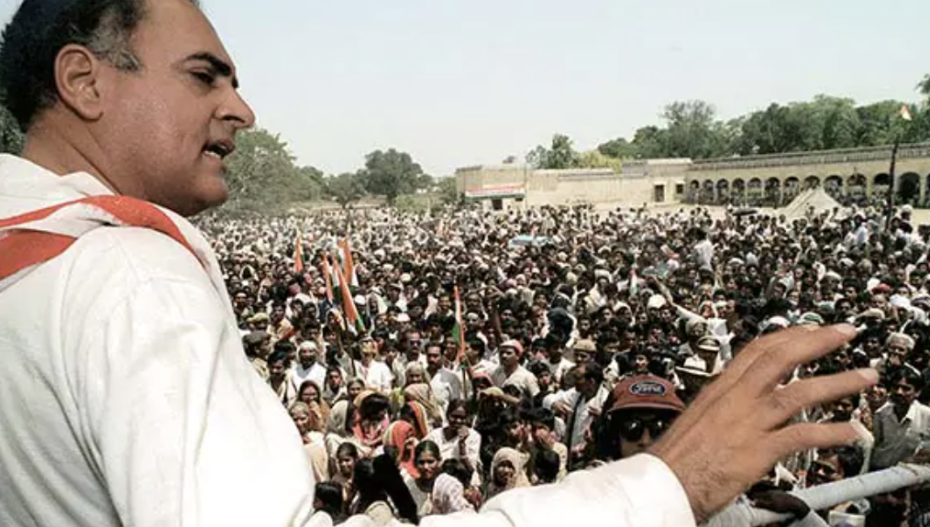In India’s electoral history, a party has crossed the ‘400 paar’ only once, when the Congress won 414 seats in the Lok Sabha elections that followed Indira Gandhi’s assassination.
Even in the initial years following Independence, when the Congress was the predominant party, its numbers were more modest – between 1951-52 and until 1977, the party’s highest seat tally was 371 in 1957, while it won more than 300 seats in 1951-52, 1957, 1962 and 1971. In the post-Emergency election of 1977 though, the Congress won just 154 seats. By 1980, it had recovered to 353 seats.
Rajiv Gandhi, who had been selected hurriedly as interim Prime Minister in the aftermath of his mother’s killing, formed the government in 1984. However, that overwhelming majority did not mean that his government was free of troubles. In fact, it remained beset with problems, from the Shah Bano verdict to opening of the locks of the temple at Babri Masjid, to the Bofors scam.
In 1989, the Congress lost power, winning 197 seats, with a coalition of parties under the Janata Dal forming the government.
While the Congress would form a government three times in the following years, it never got an absolute majority – winning 244 seats in 1991 (against the majority mark of 272), 145 in 2004 and 206 in 2009.
Not only did the Congress win a record-high number of seats in the general elections that year, it also got the highest ever vote share for a single party, at 48.12%. The last time a party had come close to this before it was when the Congress got 47.78% of the votes in the second general elections after Independence, in 1957.
Since 1984, no party has crossed the 40% mark, with the Congress coming closest in 1989 at 39.53%, followed by the Narendra Modi-led BJP in 2019 at 37.7%.
The 1984 elections were held in two parts, with most of the country voting in December that year, and Punjab and Assam in September 1985, after the Rajiv government had signed accords to end agitations in the two states.
For the Opposition, it was a complete washout. The largest national party after the Congress was the CPI(M), which won 22 seats and 5.71% of the vote share. The BJP, despite securing the second-highest vote share at 7.4%, won only 2 seats.
The non-Congress national parties won a combined 48 seats, while state parties and Independents won a total of 79.
Of the 23 states and Union territories with more than one Lok Sabha seat at the time, the party swept nine – including Madhya Pradesh (40 seats), Rajasthan (25), Haryana (10), Delhi (7) and Himachal Pradesh (4).
The Congress also dominated several other states, particularly Uttar Pradesh (including Uttarakhand at the time), where it won 83 of the 85 seats; Bihar (including Jharkhand), winning 48 of 54; Maharashtra, 43 of 48 seats; Gujarat, 24 of 26 seats; Karnataka, 24 of 28 seats; and Odisha, 20 of 21 seats.
Barring in Odisha, the Congress performance in 1984 almost matches the BJP’s in 2019.
Where the Congress did better was in the states where the BJP is still trying to make inroads. The Congress won nearly half the seats in Tamil Nadu (25 of 39), aided by ally AIADMK, which picked up 12 additional seats. In Kerala, the Congress got 13 of 20 seats.
In Jammu and Kashmir (including Ladakh), the Congress won 3 of 6 seats.
Despite its landslide win, the party struggled in states such as Andhra Pradesh, winning 6 of 42 seats; Assam, where its tally was 4 of 14; West Bengal (16 of 42 seats); and Punjab (6 of 13 seats). While the Telugu Desam Party (TDP) was the dominant party in Andhra, with 30 seats, both Assam and Punjab had their own popular regional outfits, taking on the Congress. Bengal saw the Left front take the lead with 26 seats.
In comparison, while the BJP has also struggled to gain ground in Andhra (including its erstwhile part Telangana) and Punjab, it has made massive inroads in Assam and Bengal.
The only states or UTs where the Congress did not win any seat in 1984 were Sikkim (1 seat), Tripura (2 seats) and Dadra & Nagar Haveli (1 seat).
Of its 414 seats, the Congress won nearly two-third, 293, with more than 50% of the vote share. It won another 101 seats with 40% to 50% of the vote share and 20 seats with 20% to 40% vote share.
The seat where the Congress won by the highest margin was Rajiv’s constituency Amethi, with him securing 83.67% of the votes and finishing 3.15 lakh votes ahead of his rival, despite a middling voter turnout in the seat of 58.89%.
Overall, the turnout across the country was 63.56%, the highest on record till that time. This was surpassed only in 2014, when the turnout hit 66.4%.
Also Read: Adani Group’s Portfolio Reports Record 45% EBITDA Growth in FY24












